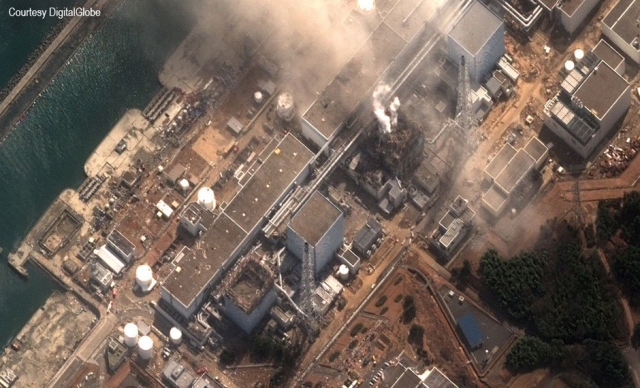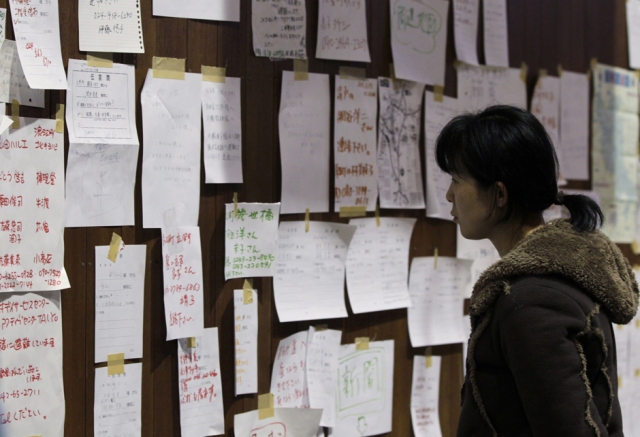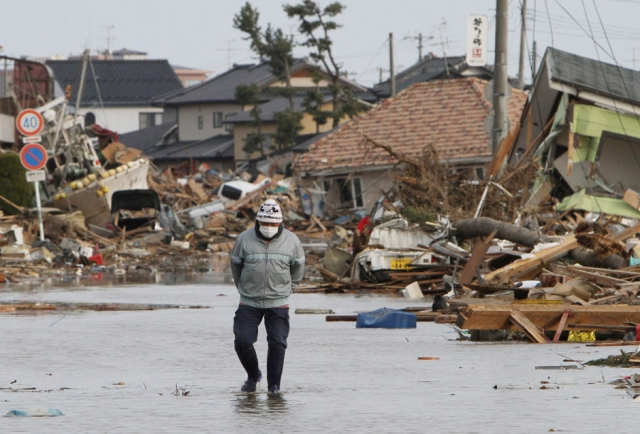After the continuous news feeds on the radioactive fallout from Fukushima Daiichi following the containment failure and reactor meltdown, this is a special blog on the last known nuclear disaster that took place at Chernobyl, Ukraine in former Soviet Russia. This post is the first in a series of stories from Chernobyl that Charles Q. Choi has written for Scientific American. Choi is a frequent contributor to Scientific American. His work has also appeared in The New York Times, Science, Nature and Wired, among others.
 “The face mask and three radiation monitors I’m wearing are grim reminders that I’m at the site of the worst nuclear accident in history. On April 26, 1986, 1:23:44 A.M. local time, explosions destroyed reactor No. 4 at the Chernobyl nuclear power plant, releasing approximately 400 times more radioactive fallout than the atomic bomb dropped on Hiroshima, according to the International Atomic Energy Agency.
“The face mask and three radiation monitors I’m wearing are grim reminders that I’m at the site of the worst nuclear accident in history. On April 26, 1986, 1:23:44 A.M. local time, explosions destroyed reactor No. 4 at the Chernobyl nuclear power plant, releasing approximately 400 times more radioactive fallout than the atomic bomb dropped on Hiroshima, according to the International Atomic Energy Agency.
Now, almost 25 years after the disaster, the Ukrainian government has officially opened the area up for tourism. But just how safe is the zone now?
Radiation
After the explosions, it was unclear how contaminated the surroundings were, so the authorities declared an arbitrary 30-kilometer distance from the reactor off-limits, and roughly 115,000 people were evacuated from the area. This “exclusion zone” is now open to tourism.
I drove to Chernobyl with health physicist Vadim Chumak at the Research Center for Radiation Medicine at the Academy of Medical Sciences of Ukraine and his colleagues. A car shuttles there every week to collect stool samples from workers to test for any plutonium they might have accidentally absorbed. (Science, like journalism, can be a dirty job, but someone has to do it.)
The world is normally bathed in a low level of radiation. In Kiev, where I started my trip, one normally receives 0.1 millionths of a sievert every hour. This is pretty much the level of radiation we saw on the road on the roughly two-hour, 150-kilometer drive into the exclusion zone, but readings on our dosimeter temporarily climb up to 4.76 millionths of a sievert per hour when our car passes through the old path of the radioactive plume from the destroyed reactor.
How safe this area is now after the accident depends on what radioactive material was released and where it went. There are four kinds of radionuclides or radioactive isotopes that are of special concern at the site. Iodine-131 is rapidly absorbed by the thyroid gland and increases the risk of childhood thyroid cancer. Cesium-137 mimics potassium inside the body, seeking out muscle. Strontium-90 acts like calcium, attracted to bone. Plutonium-239 and other isotopes can stay in the body indefinitely, irradiating organs.
These four materials escaped from the explosions to varying distances, given factors such as their mass and melting points. Iodine-131 and cesium-137 were both very broadly transported hundreds of kilometers, while strontium-90 remained in dust just 30 kilometers from the power plant and plutonium traveled only four kilometers or so.
Iodine-131 decays rapidly, and was virtually gone from the environment after only three months, Chumak says. However, cesium-137 and strontium-90 both have approximately 30-year half-lives, meaning they each take roughly three decades for half their material to decay, and plutonium-239, one the main isotopes in nuclear reactors, has a half-life of more than 24,000 years.

After the disaster, both emergency workers dubbed “liquidators” and natural forces helped to reduce airborne levels of radiation. The liquidators sprayed detergents and latex-like binding solutions from helicopters and automobiles to bind contaminants. The roads were paved to cover radioactive dust, while ploughs flipped soil over to bury polluted soil. Meanwhile, rain helped contaminants migrate down into the ground.
The exclusion zone was possibly safe for tourism “about five years after the accident,” Chumak says. Still, just because one can tour the area does not mean everywhere here is safe to tread. There are hot spots that remain highly contaminated, especially in the path of the radioactive plume. Where tourists are allowed to go and how long they will be allowed to stay will be strictly controlled to keep their risks of exposure down.
And there are some places here that remain too dangerous for tourists to go, such as the sarcophagus.
Inside the sarcophagus
Soon after firefighters extinguished the blazes from the explosions at Chernobyl, workers quickly built a structure of steel and concrete technically known as the Shelter Object but commonly known as the sarcophagus to entomb the remains of the damaged reactor and keep any more contaminants from escaping. It remains one of the most radioactive areas in the zone.
 Nowadays, workers here maintain the corroding sarcophagus, monitor the radioactive material inside, and decontaminate what they can. To enter the structure with them, I strip down to only my underwear in a “clean room” and walk in a hospital gown and slippers into a “hot room,” where I put on the pure white outfit given to everyone on site—scrubs, a jacket, trousers, a scrub cap, socks, gloves and a mask with the highest-grade filter available for dust. On top of that I don an overcoat, a hardhat and crusty boots. In
Nowadays, workers here maintain the corroding sarcophagus, monitor the radioactive material inside, and decontaminate what they can. To enter the structure with them, I strip down to only my underwear in a “clean room” and walk in a hospital gown and slippers into a “hot room,” where I put on the pure white outfit given to everyone on site—scrubs, a jacket, trousers, a scrub cap, socks, gloves and a mask with the highest-grade filter available for dust. On top of that I don an overcoat, a hardhat and crusty boots. In addition, I am carrying the radiation badge I had when I entered the 30-kilometer exclusion zone, a second radiation badge I was given when I entered the area of the plant, and a personal electronic dosimeter to tell me exactly how much radiation I am receiving.
addition, I am carrying the radiation badge I had when I entered the 30-kilometer exclusion zone, a second radiation badge I was given when I entered the area of the plant, and a personal electronic dosimeter to tell me exactly how much radiation I am receiving.
(The workers don’t normally wear lead shielding, and neither do I. Although lead can protect against radiation, it slows you down, thus increasing the dose you ultimately receive.)
The maximum dose of radiation that workers here are generally allowed on a daily shift is 0.1 thousandths of a sievert, the level of radiation one gets from a 90-minute transatlantic flight or from four hours watching a plasma screen television, says Vladimir Malyshev, chief safety officer at the Chernobyl nuclear power plant. When I am standing right in front of the sarcophagus, the readings leap up to 0.12 thousandths of a sievert per hour, or 1,200 times that seen in Kiev.
After passing an electronic checkpoint—one of a half-dozen or so that I stopped at—I find myself in the dark, gutted remains of the control room for reactor No. 4. Here engineers made the fateful errors that poisoned the Earth.
After returning from the sarcophagus, I leave everything I wore outside in a locker in the hot zone and take a mandatory shower to wash away any potential contamination. I don’t think I’ve ever wanted to be clean more in my life.
Life and wildlife
Although Chernobyl might be safe for a day of tourism, living there is another question. The Ukrainian government did allow people who originally lived in the exclusion zone to resettle on an individual basis. For instance, some areas within 30 kilometers of the explosions are relatively clean, and the elderly would probably not absorb unhealthy levels of radiation in what time they had left, Chumak says.
However, some places remain too dangerous for resettlement. “People might be allowed to live in the 30-kilometer zone, but I don’t expect anyone to live within the 10-kilometer zone, ever,” Chumak says. “There’s some plutonium there.”
Officials there did say I should look out for wildlife in the zone. “A mad wolf attacked six people here recently,” Malyshev says.
The disaster’s impact on wildlife in the zone remains hotly contested. For instance, radiation biologist Ron Chesser at Texas Tech University in Lubbock and his colleagues suggest the area is thriving with life now that humans have left, finding that the wild boar population there has grown 10 to 15 times than what it was before the accident, and that other fauna are often seen in the area, such as wolves, rabbits, red deer, black storks and moose. Their genetic work suggests that any effects of radiation are subtle enough to not lead to any mutations passed down across generations, with the animals perhaps acclimatizing to any damage by boosting their genetic repair mechanisms. As bad as the radiation is, the effects of humans on the environment might have been worse, Chesser concludes.
On the other hand, biologist Tim Mousseau at the University of South Carolina at Columbia and his colleagues have found that  species richness of forest birds was reduced by more than half when comparing sites with normal background levels of radiation to sites with the highest levels in the exclusion zone, and the numbers of bumblebees, grasshoppers, butteries, dragonflies and spiders decreased too. Analysis of more than 7,700 barn swallows in Chernobyl and other areas in Ukraine and Europe suggested ones from in or near the exclusion zone had higher levels of abnormalities such as deformed toes, beaks and eyes or aberrant coloration, and recent work also suggests that birds living in areas with high levels of radiation around Chernobyl have smaller brains.
species richness of forest birds was reduced by more than half when comparing sites with normal background levels of radiation to sites with the highest levels in the exclusion zone, and the numbers of bumblebees, grasshoppers, butteries, dragonflies and spiders decreased too. Analysis of more than 7,700 barn swallows in Chernobyl and other areas in Ukraine and Europe suggested ones from in or near the exclusion zone had higher levels of abnormalities such as deformed toes, beaks and eyes or aberrant coloration, and recent work also suggests that birds living in areas with high levels of radiation around Chernobyl have smaller brains.
Both teams stand by their own work and suggest the other made errors related to geographic variability.
Tourist attraction?
So what can tourists see at Chernobyl? One can often see and feed giant catfish in the 22-square-kilometer nuclear power plant cooling pond, although during cold weather, the pond is frozen over and covered in snow. In the distance, one can also see a giant radar grid roughly 150 meters high—taller than the Great Pyramid of Giza’s current height—once meant to track any nuclear missiles launched from the United States. “It needed a lot of power, which is why it was near Chernobyl,” Chumak explains.
The city of Pripyat, abandoned after the accident, is frozen in time, with the Communist hammer and sickle still adorning streetlights here. Nature is reclaiming the area, with white birch and green pines hiding many of the blocky Soviet buildings and animal tracks fresh on the snow still covering the ground here in the first week of March.
By a dock near a riverside cafe in Pripyat, the scientists I traveled with started gathering pussy willows, completely unbidden. These flowers bloom under the snow, and the men want to bring them back for International Women’s Day on March 8. “These mean spring,” says physicist Vitalii Volosky at the Research Center for Radiation Medicine in Kiev.
Despite the official announcement, tourism to Chernobyl is nothing new—trips have been going there for about a decade. The recent publicity regarding tourism may have its roots in the economic impact of Chernobyl—even two decades after the disaster, roughly 6 percent of the national budgets of both Ukraine and Belarus were still devoted to Chernobyl-related benefits and programs, according to a 2005 report from the Chernobyl Forum, comprised of eight United Nations agencies and the governments of Ukraine, Belarus and Russia. “There is this motivation there to do what can be done to return some of this land to productive use,” Mousseau says.
Among those who lived through the disaster, the idea of tourism to Chernobyl brings up strong emotions, just as it might for New Yorkers dealing with 9/11. “If we are wise, we will make Chernobyl a museum for humankind just like Hiroshima and Nagasaki,” Chumak says.
Among the younger generation in Kiev, there is real interest in visiting. “My son really wants to go, as do a couple of young students here,” Chumak says.
Still, for others, tourism to Chernobyl holds no attraction. “Personally, every trip I make there is not a positive one,” says physicist Elena Bakhanova at the Research Center for Radiation Medicine in Kiev. “It was a human error, a sign of human foolishness.”
Images: Charles Q. Choi in the control room for destroyed reactor No. 4 at the Chernobyl nuclear power plant; Health physicist Vadim Chumak at the Research Center for Radiation Medicine at the Academy of Medical Sciences of Ukraine in Kiev. He is wearing a respirator mask with the highest-grade filter available against aerosols, to protect against airborne contamination; The entrance to a “hot room” at the facility where workers at Chernobyl change their clothing. In the “clean room,” I took off all my clothing except my underwear. In the hot room, I was given clothing to wear in the sarcophagus; Visitor’s badge and radiation badge. The visitor’s badge has a microchip scannable at electronic checkpoints. The radiation badge is a dosimeter that measures my exposure to radiation—the silver disk on the badge measures the radiation my skin received, while the black bump measured the levels deeper tissues experienced; This giant radar grid relatively close to the Chernobyl nuclear power plant was once meant to track any nuclear missiles launched from the United States. It is roughly 150 meters high, taller than the Great Pyramid of Giza’s current height.
0.000000
0.000000














































































